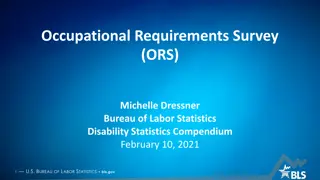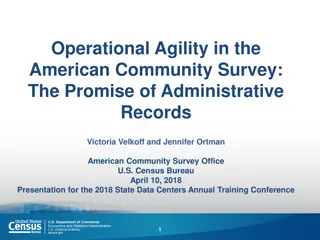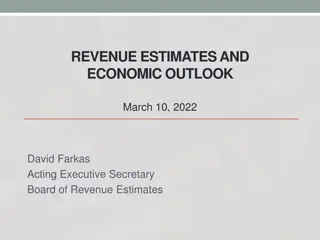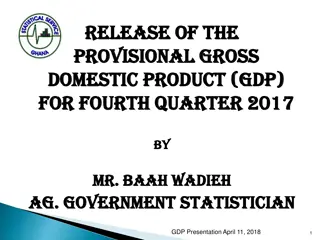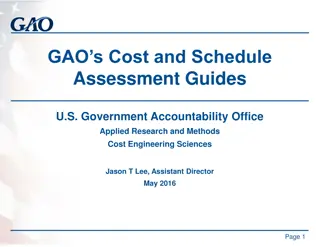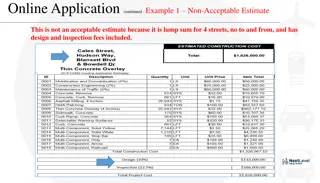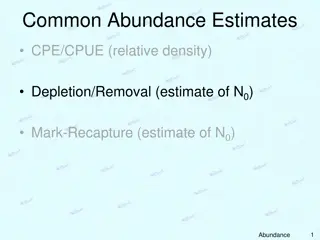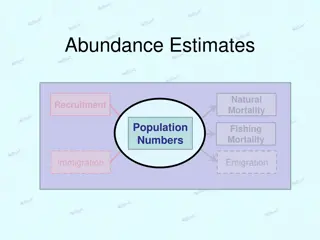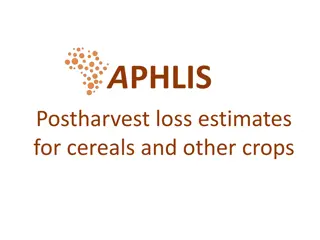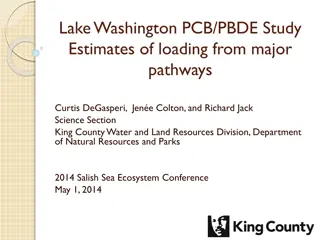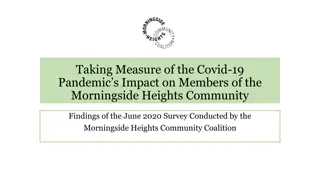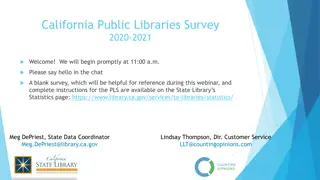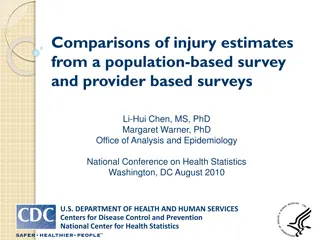Understanding Multiyear Estimates from the American Community Survey
This comprehensive guide delves into the concept of multiyear estimates from the American Community Survey (ACS). It explains what multiyear estimates are, when to use them, considerations to keep in mind, making comparisons with them, examples of their application, definitions of period and multiyear estimates, population thresholds, labeling conventions, and the construction process. The content emphasizes the importance of correctly interpreting and utilizing multiyear estimates for accurate data analysis and decision-making.
- Multiyear Estimates
- American Community Survey
- Data Analysis
- Population Thresholds
- Data Interpretation
Download Presentation

Please find below an Image/Link to download the presentation.
The content on the website is provided AS IS for your information and personal use only. It may not be sold, licensed, or shared on other websites without obtaining consent from the author. Download presentation by click this link. If you encounter any issues during the download, it is possible that the publisher has removed the file from their server.
E N D
Presentation Transcript
Understanding Multiyear Estimates from the American Community Survey Updated February 2013
Overview What are multiyear estimates? When should you use multiyear estimates? What should you be aware of when using multiyear estimates? How can you use multiyear estimates to make comparisons? Example of using multiyear estimates 2
What is a Period Estimate? Definition An estimate that describes the average characteristics of an area over a specific time period Period for ACS 1-year estimates is the calendar year Different from a point-in-time estimate 3
What is a Multiyear Estimate? Definition A period estimate that encompasses more than one calendar year Period for ACS multiyear estimates is either 3 or 5 calendar years 4
Population Thresholds for ACS Estimates 1-year estimates 3-year estimates 5-year estimates 65,000+ people X X X 20,000+ people X X Less than 20,000 people X 5
How to Label Multiyear Estimates ACS estimates based on data collected from 2005-2007 should not be labeled 2006 or 2007 estimates Multiyear estimates do not represent any one year or the midpoint of a period Correct labeling for multiyear estimate: The child poverty rate for the 2005-2007 period was X percent. 6
Constructing Multiyear Estimates Data are pooled across 36 or 60 months Data are weighted to produce estimates Estimates are controlled for age, sex, race, and Hispanic origin Multiyear estimates are not an average of 1-year estimates 7
Overview What are multiyear estimates? When should you use multiyear estimates? What should you be aware of when using multiyear estimates? How can you use multiyear estimates to make comparisons? Example of using multiyear estimates 8
Use Multiyear Estimates When No 1-year estimate is available Margins of error for 1-year estimates are larger than required Analyzing data for small population groups 9
Currency vs. Reliability Currency Reliability 1-year estimates provide information based on the last year Larger sample sizes produce estimates that are more statistically reliable 3-year estimates provide information based on the last year and the 2 years before that 3-year estimates are based on 3 times as many sample cases as 1-year estimates 5-year estimates provide information based on the last year and the 4 years before that 5-year estimates are based on 5 times as many sample cases as 1-year estimates 10
Reliability Confidence Interval Source: 2009 American Community Survey 1-year, 3-year, and 5-year estimates, Table S1201 Marital Status 11
Overview What are multiyear estimates? When should you use multiyear estimates? What should you be aware of when using multiyear estimates? How can you use multiyear estimates to make comparisons? Example of using multiyear estimates 12
Inflation Adjustment Dollar-valued data items are inflation adjusted to the most recent year for the period Income, rent, home value, and energy costs Adjusted using inflation factors based on the Consumer Price Index (CPI) Adjustment designed to put the data into dollars with equal purchasing power 13
Geographic Boundaries Multiyear estimates are based on geographic boundaries as of January 1 of the last year in the multiyear period Boundary Annexation Survey collects boundary changes Boundaries of other statistical areas will be updated every decade in conjunction with the decennial census 14
Geographic Boundaries Amarillo city, Texas 15
Population Controls Estimates of housing units and people are controlled to the population estimates derived from the Population Estimates Program Multiyear estimates are controlled to the average of the individual year s estimates for the period 16
Overview What are multiyear estimates? When should you use multiyear estimates? What should you be aware of when using multiyear estimates? How can you use multiyear estimates to make comparisons? Example of using multiyear estimates 17
Comparing Across Geographies Only compare the same type of estimate 1-year estimates to other 1-year estimates 3-year estimates to other 3-year estimates 5-year estimates to other 5-year estimates Same time period 18
Counties in Kentucky, by Population Size Figure 3: Counties in Kentucky by Population Size, 2007 Population, July 2007 Population, July 2007 Less than 20,000 people 20,000 to 64,999 people 65,000 or more people 0.00 to 20000.00 20000.00 to 65000.00 65000.00 to 800000.00 19
Comparing Data 2009 2007-2009 2005-2009 Fayette County X X X Franklin County X X Fulton County X 20
Comparing Across Time Periods Same geographic area Use caution if geographic boundaries have changed over time Easier to compare non-overlapping periods Make comparisons using the same length time period 21
Comparing ACS Data with Census 2000 Global differences exist between ACS and Census 2000 Comparisons can be made for most population and housing subjects http://www.census.gov/acs/www/guidance_for_data_users/ comparing_data/ 23
Overview What are multiyear estimates? When should you use multiyear estimates? What should you be aware of when using multiyear estimates? How can you use multiyear estimates to make comparisons? Example of using multiyear estimates 24
Tracking Social Change 7 school districts in the county of Centerville, USA Question to be answered: Has there been a change in the population with a high school diploma in these school districts? 25
Determining Which Data To Use Since the data must be current, decennial census long form data for 1990 and 2000 are not adequate A data analyst turns to the ACS data for a look at trends since 2000 Only data available are three-year ACS estimates for 7 school districts 26
Centerville County, USA A B D C E F G 27
3-Year Estimates Available for the School Districts, 2005-2011 28
Choosing the Estimates 2005-2007 vs. 2006-2008 2005-2007 vs. 2007-2009 2005-2007 vs. 2008-2010 2005-2007 vs. 2009-2011 2006-2008 vs. 2007-2009 2006-2008 vs. 2008-2010 2006-2008 vs. 2009-2011 2007-2009 vs. 2008-2010 2007-2009 vs. 2009-2011 2008-2010 vs. 2009-2011 29
Summary: What Have We Learned? Multiyear estimates are period estimates Multiyear estimates should be interpreted and labeled as period estimates Data users should consider the tradeoffs of currency versus reliability 31
Summary: What Have We Learned? Comparisons between estimates of different geographies should be based on ACS data from the same time periods It is easier to compare estimates from non-overlapping periods 32
Additional ACS Resources ACS website (census.gov/acs) American FactFinder (factfinder2.census.gov) QuickFacts (quickfacts.census.gov) DataFerrett (dataferrett.census.gov) FAQs (https://ask.census.gov/faq.php?id=5000&rtopic=1805) 33
Final Thoughts The U.S. Census Bureau measures the nation s People, Places and Economy Census Bureau statistics are how America knows what America needs The Census Bureau is the leading source of quality, timely and relevant information about our nation s people and economy 34
Contact Information Subscribe to Email Updates http://www.census.gov/acs Visit the ACS/PRCS website: http://www.census.gov/acs Contact by Telephone: 1-800-923-8282 Submit a Question: https://ask.census.gov 35





